driver seat adjustment AUDI S6 2014 Owners Manual
[x] Cancel search | Manufacturer: AUDI, Model Year: 2014, Model line: S6, Model: AUDI S6 2014Pages: 304, PDF Size: 76.32 MB
Page 54 of 304
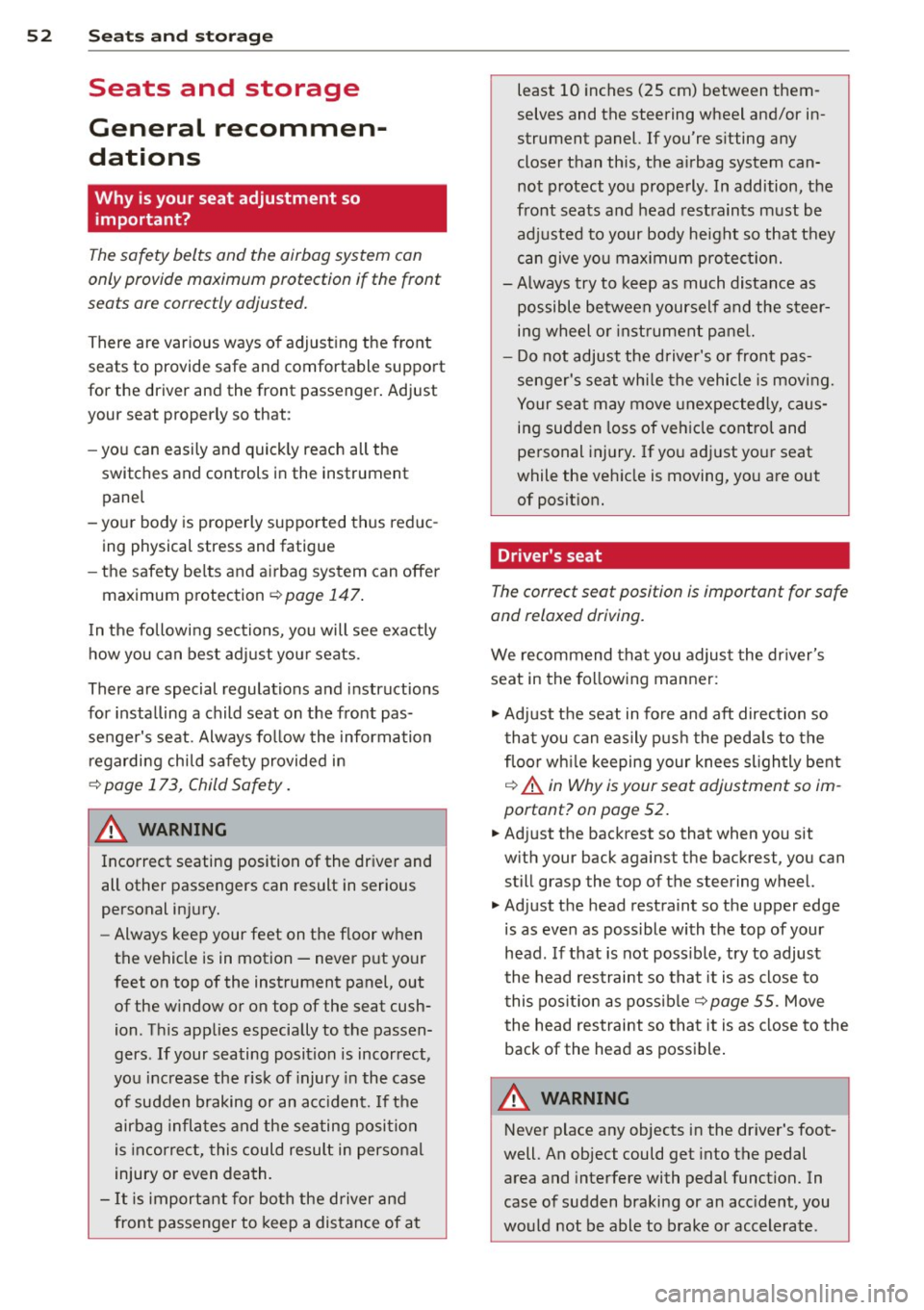
52 Seat s a nd s tor ag e
Seats and storage
General recommen
dations
Why is your seat adjustment so
important?
The safety belts and the airbag system can
only provide maximum protection if the front
seats are correctly adjusted.
There are various ways of adjust ing the front
seats to provide safe and comfortable support
for the driver and the front passenger . Adjust
you r seat prope rly so that :
- you can easily and quick ly reach all the
switches and controls in the instrument
panel
-your body is prope rly supported thus reduc
ing physical stress and fatigue
- the safety be lts and a irbag system can offer
maximum protection ¢
page 147.
In the following sec tions, you will see exactly
how you can best adjust you r seats .
There are special regulations and instructions
for insta lling a child seat on the front pas
senger's seat. Always fo llow the information
regarding ch ild safety provided in
q page 173, Child Safety .
A WARNING
Incorrect seating position of the dr iver and
all other passengers can result in serious
personal in jury.
- Always keep your feet on the floor when
the vehicle is in motion -never p ut your
feet on top of the instrument panel, out of the w indow or on top of the seat cush
ion . Th is applies especially to the passen
gers . If your seating position is incorrect,
yo u increase the r isk of injury in the case
of sudden braking or an a ccident. If th e
a ir bag infla tes and the se ating position
is inco rre ct, this could resul t in personal
injury o r even death.
- It is import ant for both the driver an d
front passenger to keep a distance of at least 10 inches (25 cm) between them
selves and the steering wheel and/or in
strument panel. If you're s itting any
closer than th is, the a irbag system can
not protect you properly . In addition, the
front seats and head restraints must be adjusted to your body height so that they
can give you max imum protect ion.
- Always try to keep as much distance as
possible between yourself and the steer
ing wheel o r inst rument pane l.
- Do not adjust the driver's o r front pas
senger's seat whi le the vehicle is moving.
Your sea t may move unexpected ly, caus
ing sudden loss of vehicle cont rol and
personal injury . If yo u adjust yo ur seat
while the veh icle is moving, yo u are out
of posit ion.
Driver's seat '
The correct seat position is important for safe
and relaxed driving.
We recommend tha t you adjus t the dr iver's
seat in the fo llowing manner :
.,. Adjust t he seat in fore and aft direction so
t ha t you can eas ily push the peda ls to the
floor w hile keeping your knees sl igh tly bent
q A in Why is your seat adjustment so im
portant? on page 52.
.. Adjust the backrest so that when you sit
w ith your back against t he backrest, you can
still grasp the top of the steering wheel.
.. Adjust the head restraint so the upper edge
is as even as poss ible with the top of your
head . If that is not poss ible , try to adjust
t he head restraint so that it is as close to
t his pos it ion as possib le
q page 55. Move
the head restraint so that it is as close to the
back of the head as poss ible .
A WARNING "--
Neve r place any objects in the dr iver's foot-
well. An object could get into the pedal
area and interfere with pedal function. In
case of sudden braking or an acc ident, you
wo uld not be able to brake or accelerate .
Page 57 of 304
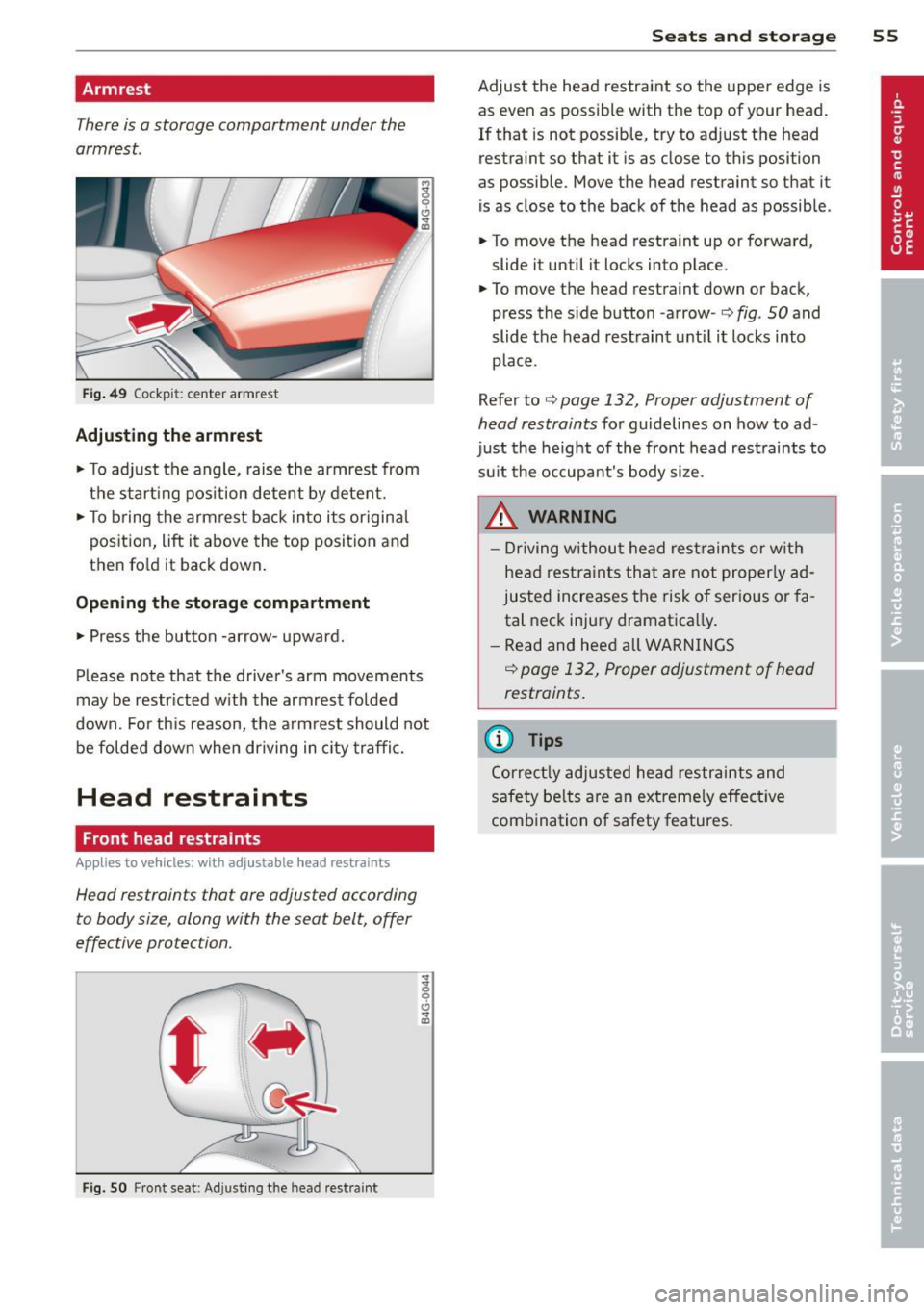
Armrest
There is a storage compartment under the
armrest .
Fig. 49 Cockp it : center armrest
Adjusting the armrest
.. To adjust the angle, raise the armrest from
the starting position detent by detent.
.. To b ring the armrest back into its origina l
position, lift it above the top position and
then fold it back down.
Opening the storage compartment
.. Press the button -arrow- upward.
Please note that the driver's arm movements
may be restr icted w ith the armrest folded
down. For this reason, the armrest should not
be folded down when driving in city traffic.
Head restraints
Front head restraints
Applies to vehicles: with adjustable head restraints
Head restraints that ore adjusted according
to body size, along with th e seat belt, offer
effective protection.
F ig. 50 Front seat: Ad justing t he head restraint
Seats and storage 55
Adjust the head restraint so the upper edge is
as even as possible with the top of your head.
If that is not possible, try to adjust the head
restraint so that it is as close to this position
as possible. Move the head restraint so that it
is as close to the back of the head as possible .
.. To move the head restraint up or forward,
slide it until it locks into p lace .
.. To move the head restraint down or back,
press the side button -arrow -
c:> fig. SO and
slide the head restraint until it locks into
place .
Refer to
c:> page 132, Proper adjustment of
head restraints
for guidelines on how to ad
just the height of the front head restraints to
su it the occupant's body size.
.&_ WARNING
- Driving without head restraints or with
head restraints that are not properly ad
justed increases the risk of serious or fa
tal neck injury dramatica lly .
- Read and heed all WARNINGS
i=> page 132, Proper adjustment of head
restraints.
(D Tips
Correctly adjusted head restraints and
safety be lts are an extreme ly effective
combination of safety features.
-
Page 58 of 304
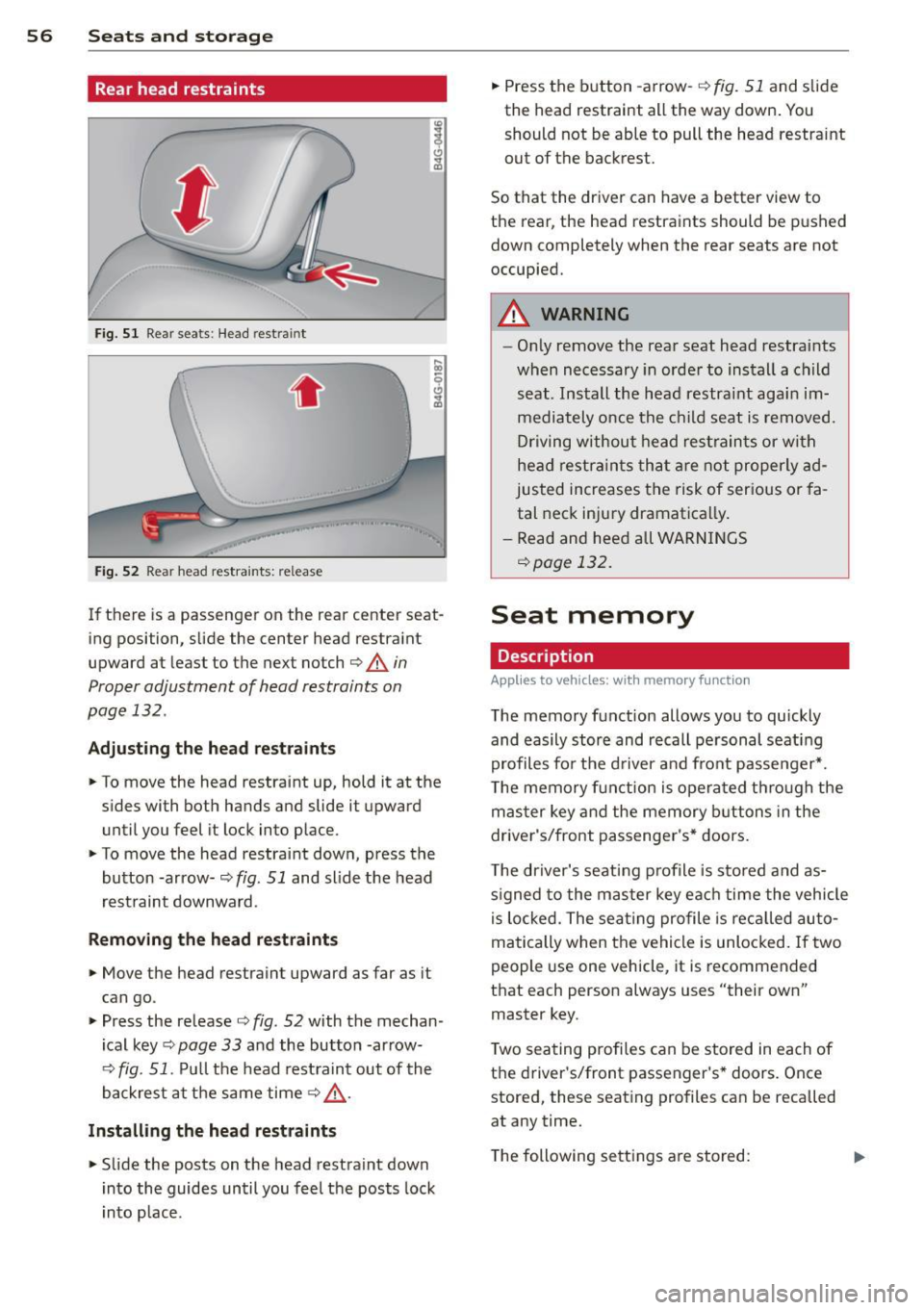
56 Seats and storage
Rear head restraints
Fig. 51 Rear seats: Head restra int
. .
Fig . 52 Rear head restraints: release
If there is a passenger on the rear center seat
ing position, slide the center head restraint
upward at least to the next notch
c::> A in
Proper adjustment of head restraints on
page 132 .
Adjusting the he ad restr aint s
• To move the head restraint up, hold it at the
sides with both hands and slide it upward
until you feel it lock into place.
• To move the head restraint down, press the
button -ar row-
c::> fig. 51 and slide the head
rest raint downward.
Rem oving the head re straints
• Move the head restraint upward as far as it
can go.
• Press the release
c::> fig. 52 with the mechan
ical key
c::> page 33 and the button -ar row-
c::> fig. 51. Pu ll the head rest raint out of the
backrest at the same time
c::> .,&. .
Install ing th e he ad re str aints
• Slide the posts on the head restraint down
into the guides until you feel the posts lock
i nto place. •
Press the b utton -arrow-
c::> fig. 51 and slide
the head restraint all the way down . You
should not be able to pull the head restraint
out of the backrest.
So that the dr iver can have a better view to
the rear, the head restraints should be p ushed
down completely when the rear seats are not
occupied.
A WARNING
-- On ly remove the rear seat head restraints
when necessary in order to install a child
seat . Install the head restraint agai n im
mediately once the child seat is removed.
Dr iving without head rest rain ts or wi th
head restra ints tha t a re no t properly ad
justed increases the risk of ser ious or fa
tal neck injury dramatically .
- Read and heed all WARN INGS
c::>page 132.
Seat memory
Description
Applies to vehicles: with memory function
The memory function allows you to quickly
and easily stor e and recall pe rsonal seati ng
profiles for the d river a nd front passenger *.
T he memory f un ction is opera ted th ro ugh the
mas ter key and the memory buttons in the
driver's/front passenger's* doors .
T he driver's seat ing profile is stored and as
s igned to the master key ea ch time the vehicle
i s lo cked. The sea ting profile is rec alled au to
matically when the vehicle is unlocked. If two
people use one vehicle, it is recommended
that each person always uses "their own" master key.
T wo sea ting profiles can be stored in each of
the d river's/front passenger's * doors. Once
stored, these seating profiles can be recalled
at any time.
T he following sett ings a re stored:
Page 130 of 304
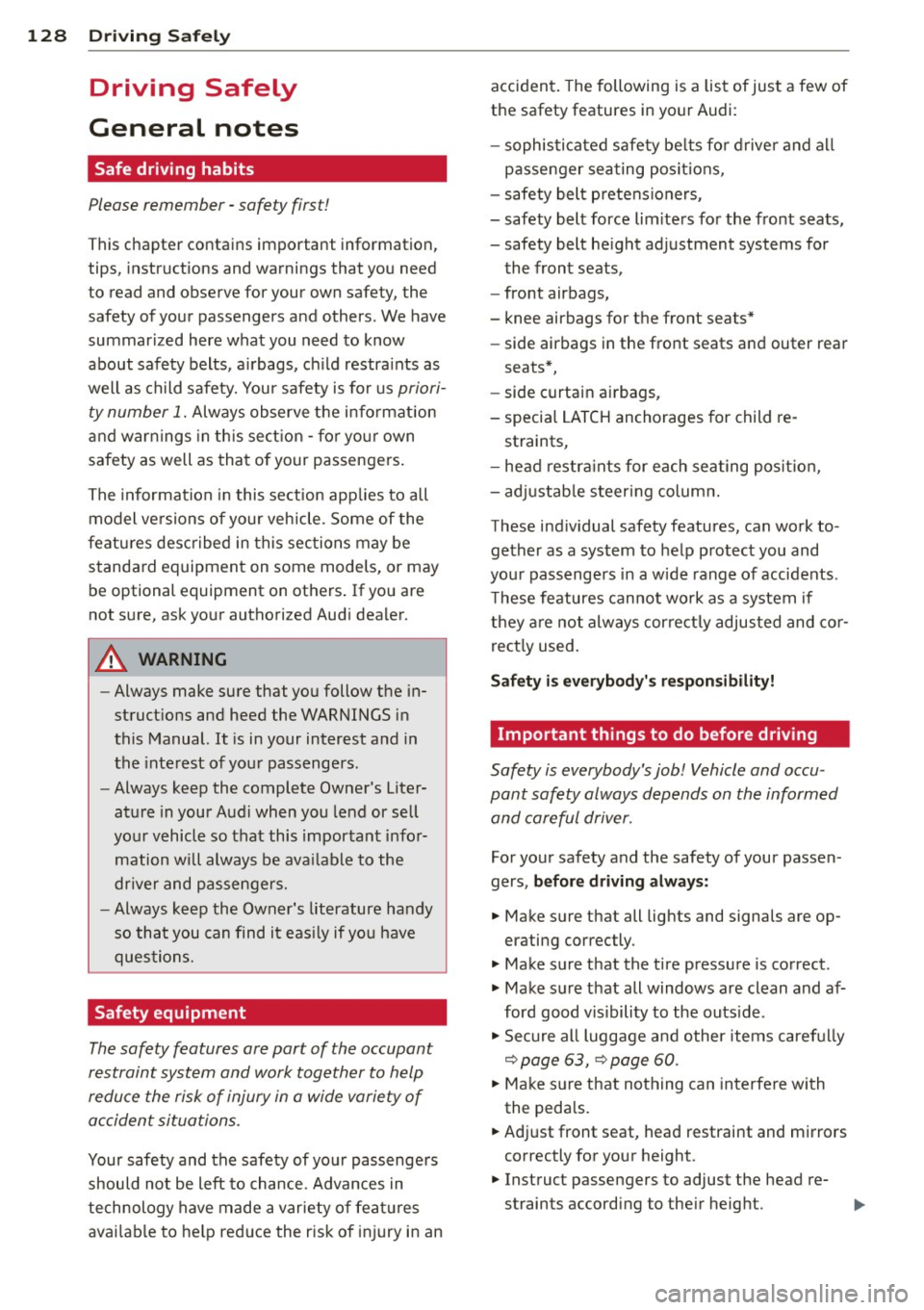
128 Driving Safely
Driving Safely
General notes
Safe driving habits
Please remember -safety first!
This chapter contains important information,
tips, instructions and warnings that you need
to read and observe for your own safety, the
safety of your passengers and others . We have
summarized here what you need to know
about safety belts, airbags, child restraints as
well as child safety. Your safety is for us
priori
ty number 1.
Always observe the information
and warnings in this section - for your own
safety as well as that of your passengers.
The information in this section applies to all
model versions of your vehicle . Some of the
features described in this sections may be
standard equipment on some models, or may
be optional equipment on others. If you are
not sure, ask your authorized Audi dealer.
A WARNING
- Always make sure that you follow the in
structions and heed the WARNINGS in
this Manual. It is in your interest and in
the interest of your passengers.
- Always keep the complete Owner's Liter
ature in your Audi when you lend or sell
your vehicle so that this important infor
mation will always be available to the
driver and passengers.
- Always keep the Owner's literature handy
so that you can find it easily if you have
questions.
Safety equipment
The safety features are part of the occupant
restraint system and work together to help
reduce the risk of injury in a wide variety of
accident situations.
Your safety and the safety of your passengers
should not be left to chance. Advances in
technology have made a variety of features
available to help reduce the risk of injury in an accident.
The following is a list of just a few of
the safety features in your Audi:
- sophisticated safety belts for driver and all
passenger seating positions,
- safety belt pretensioners ,
- safety belt force limiters for the front seats,
- safety belt height adjustment systems for
the front seats,
- front airbags,
- knee airbags for the front seats*
- side airbags in the front seats and outer rear
seats*,
- side curtain airbags ,
- special LATCH anchorages for child re-
straints,
- head restraints for each seating position,
- adjustable steering column.
These individual safety features, can work to gether as a system to help protect you and
your passengers in a wide range of accidents .
These features cannot work as a system if
they are not always correctly adjusted and cor
rectly used.
Safety is everybody's responsibility!
Important things to do before driving
Safety is everybody 's job! Vehicle and occu
pant safety always depends on the informed and careful driver .
For your safety and the safety of your passen
gers,
before driving always:
.. Make sure that all lights and signals are op
erating correctly.
.. Make sure that the tire pressure is correct .
.. Make sure that all windows are clean and af
ford good visibility to the outside .
.. Secure all luggage and other items carefully
q page 63, q page 60 .
.. Make sure that nothing can interfere with
the pedals.
.. Adjust front seat, head restraint and mirrors
correctly for your height.
.. Instruct passengers to adjust the head re-
straints according to their height . .,..
Page 134 of 304
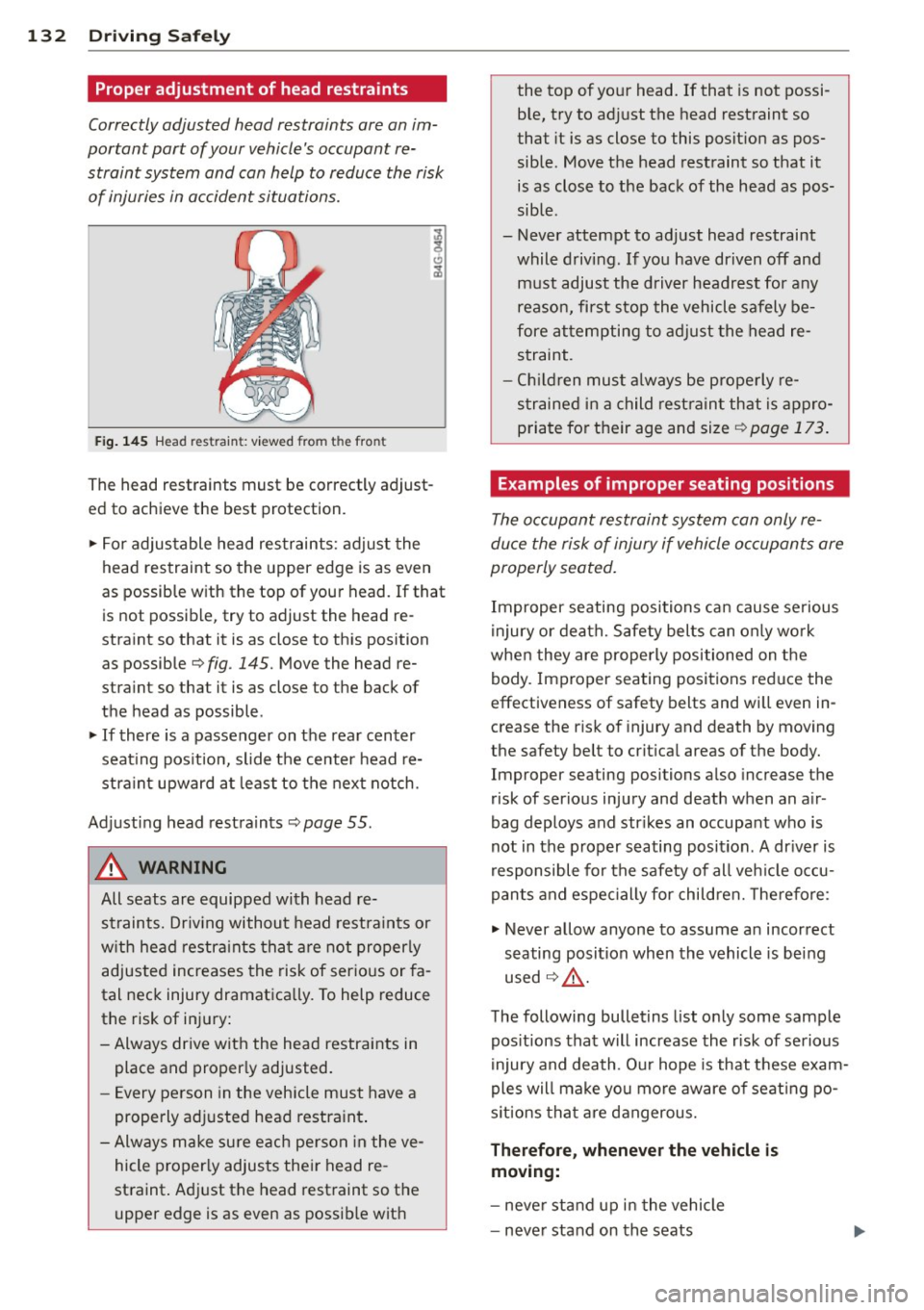
132 Driving Safel y
Proper adjustment of head restraints
Correctly adjusted head restraints are an im
portant part of your vehicle's occupant re
straint system and can help to reduce the risk
of injuries in accident situations.
Fig . 145 H ead restraint: viewed from the front
The head restraints must be correctly adjust
ed to achieve the best protection.
i,.. For adjustable head restraints: adjust the
head restraint so the upper edge is as even
as possible with the top of your head. If that
is not possible, try to adjust the head re
stra int so that it is as close to this position
as possible ¢
fig. 145. Move the head re
stra int so that it is as close to the back of
the head as possible .
i,.. If there is a passenger on the rear center
seat ing pos ition, slide the center head re
stra int upward at least to the next notch.
Adjust ing head restraints¢
page 55.
A WARNING
All seats are equipped with head re
straints. Dr iv ing without head restraints or
w ith head restra ints tha t are not properly
adjusted increases the risk of ser io us or fa
tal neck injury dramatically. To help reduce
the risk of injury:
- Always drive with the head restraints in
place and proper ly adjusted.
- Every pe rson in the vehicle must have a
properly ad justed head restra int .
- Always make su re each pe rson in the ve
hicle proper ly adjusts the ir head re
straint . Ad just the head restraint so the
upper edge is as even as possib le with the top of yo
ur head. If that is not possi
ble, t ry to ad just the head restraint so
that it is as close to this position as pos
sible. Move the head rest raint so that it
is as close to the back of the head as pos
sible.
- Never attempt to adjust head restraint
while driving. If you have driven off and m ust adjust the driver headrest for any
reason, first stop the vehicle safely be
fore at tempting to a djust the head re
straint.
- Ch ild ren mus t always be prope rly re
s trained in a child rest rain t that is appro
p ria te fo r their age and size ¢
page 173.
Examples of improper seating positions
The occupant restraint system can only re
duce the risk of injury if vehicle o ccupants are
properly seated.
Improper seating positions ca n cause serious
injury or death. Safety belts can only wo rk
whe n they are properly positioned on the
body. Improper seating positions reduce the
effectiveness of safety belts and will even in
crease the risk of injury and death by moving
the safety belt to crit ica l areas of the body.
Improper seating positions also increase the
risk of serious injury and death when an air
bag deploys and str ikes an occupant who is
not in the p roper s eating position. A dr iver is
r esponsible fo r the safety of all veh icle occu
pants and espe cially for child ren. The re fore:
i,.. Never allow anyone to assume an incorrect
seating position when the vehicle is being
used ¢& .
The following bullet ins list o nly some sample
pos itions that will increase the r isk of serious
injury and death. Our hope is that t hese exam
ples will make yo u more aware o f seat ing po
s it ions tha t are dangerous.
Therefore , whenever the vehicle is
moving:
- neve r stand u p in the vehicle
- neve r stand on the seats
Page 146 of 304
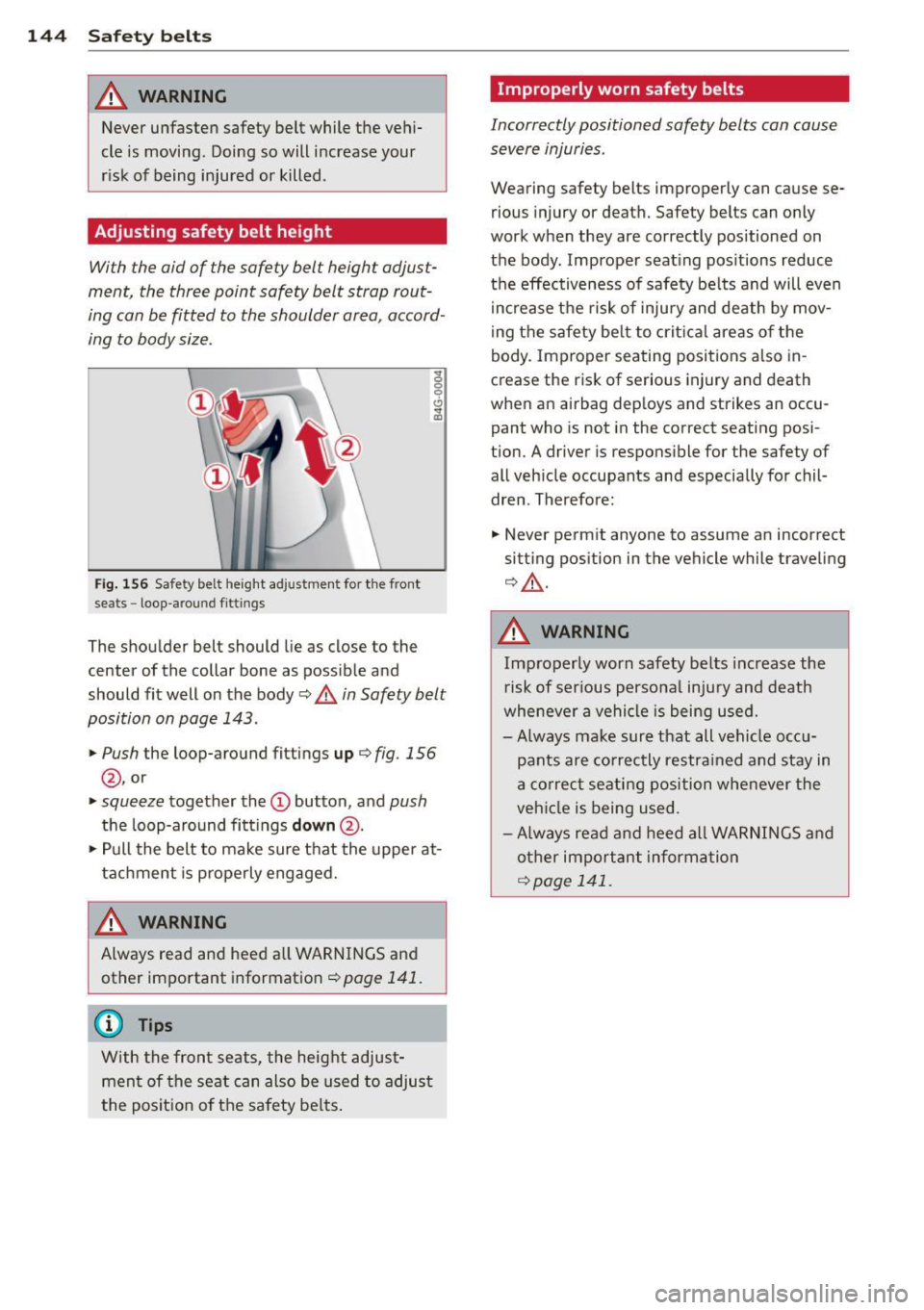
144 Safet y belt s
A WARNING
Never unfasten safety belt while the vehi
cle is moving. Doing so will increase your
r isk of being injured or killed .
Adjusting safety belt height
With the aid of the safety belt height adjust
ment, the three point safety belt strap rout
ing can be fitted to the shoulder area, accord
ing to body size .
Fig. 156 Safety belt height adjustment for the front
sea ts - loop -around f ittings
The shoulder belt should lie as close to the
center of the collar bone as possible and
should fit well on the body¢
A in Safety belt
position on page 143.
,. Push
the loop-around fittings up ¢fig. 156
@ , or
"'"squeeze together the@ button, and push
the loop-around fitt ings down @.
"'" Pull the belt to make sure that the upper at
tachment is p roperly engaged.
A WARNING
Always read and heed a ll WARNINGS and
other important information¢
page 141 .
@ Tips
With the fron t seats, the height adjust
men t of the sea t can also be used to adjus t
the posit ion of the safety be lts.
Improperly worn safety belts
Incorrectly positioned safety belts can cause
severe injuries .
Wearing safety belts improperly can cause se
rious injury or death. Safety belts can o nly
work when they are correctly positioned on
the body . Improper seating pos itions reduce
the effectiveness of safety belts and will even
i ncrease t he risk of injury and death by mov
ing the safety be lt to crit ica l areas o f the
body. Improper seating positions also in
crease the risk of serious injury and death
when an airbag deploys and strikes an occu
pant who is not in the correct seating posi
tion. A driver is respons ible for the safety of
all veh icle occupants and especially for chil
dren . Therefore:
"'" Never permit anyone to assume an incorrect
sitting position in the vehicle while traveling
¢&_ .
A WARNING
Improperly worn safety be lts increase the
r isk of ser ious persona l injury and death
whenever a vehicle is being used.
- Always ma ke sure that all vehicle occ u
pants are co rrectly restra ined and stay in
a correc t seating position whe never the
veh icle is being used .
- Always read and heed all WAR NINGS a nd
o ther important inform ation
¢page 141.
Page 149 of 304
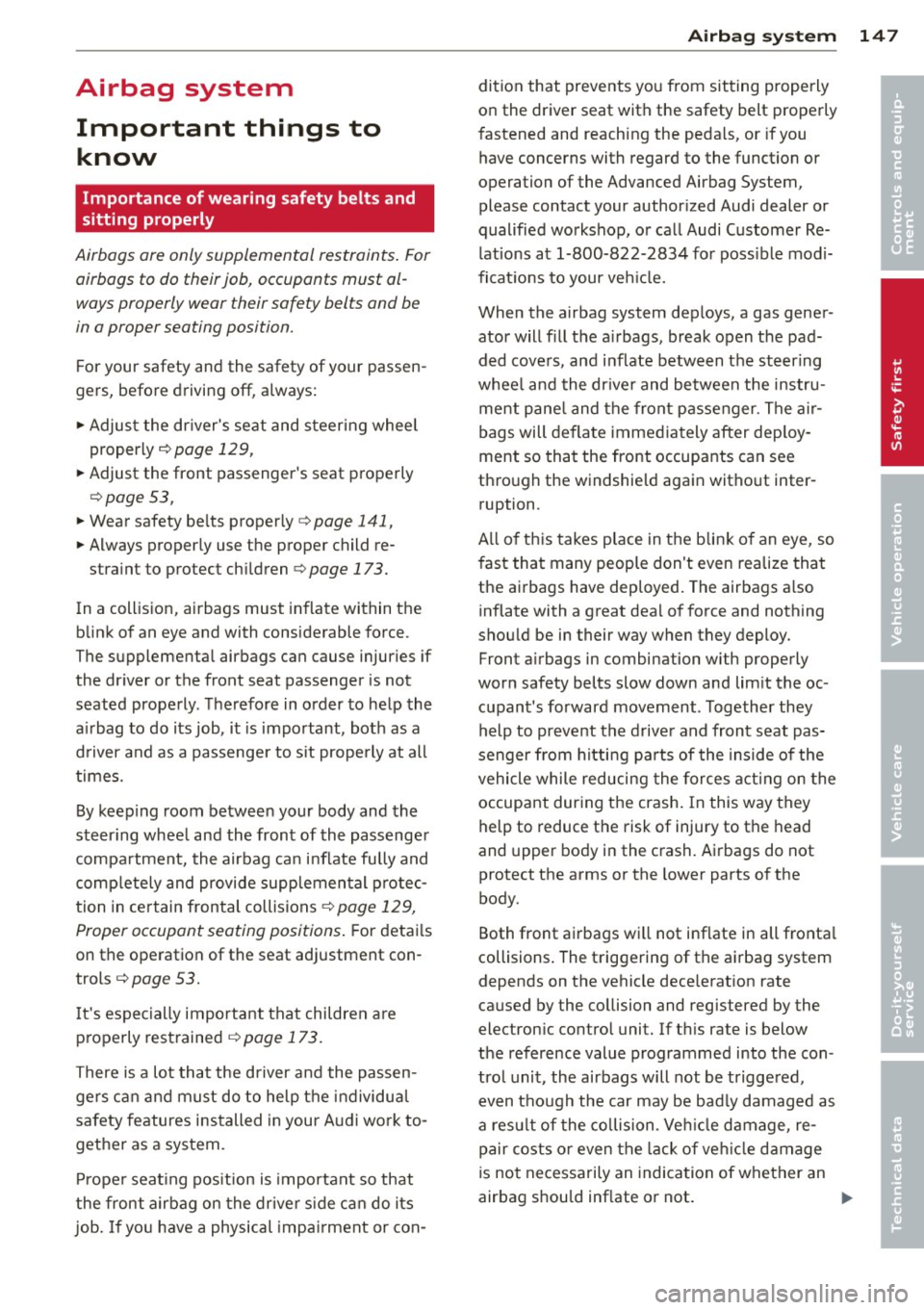
Airbag system Important things to know
Importance of wearing safety belts and
sitting properly
Airbags are only supplemental restraints. For
airbags to do their job, occupants must al
ways properly wear their safety belts and be
in a proper seating position.
For your safety and the safety of your passen
gers, before driving off, always:
"" Adjust the driver's seat and steering wheel
properly¢
page 129,
"" Adjust the front passenger's seat properly
¢ page 53,
""Wear safety be lts properly r::::> page 141,
""Always properly use the proper child re-
straint to protect chi ldren
r::::> page 173.
In a collision, airbags must inflate within the
blink of an eye and with considerable force.
The supplemental airbags can cause injuries if
the driver or the front seat passenger is not
seated properly . T herefore in order to help the
a irbag to do its job, it is important, both as a
driver and as a passenge r to s it properly at all
times.
By keeping room between your body and the
steer ing whee l and the front of the passenger
compartment, the airbag can inflate fully and
comp lete ly and provide supp lemental protec
tion in certain frontal collisions
r::::> page 129,
Proper occupant seating positions.
F or detai ls
on the operation of the seat adjustment con
trols ¢
page 53.
It's especially important that children a re
properly restrained
r::::> page 173.
There is a lot that the driver and the passen
gers can and must do to help the individual
safety features installed in your Aud i work to
gether as a system.
Prope r seat ing pos ition is important so that
the front airbag on the driver side can do its
job. If you have a physical impa irment or con-
A irbag system 147
dition that prevents you from sitting properly
on the driver seat with the safety belt properly
fastened and reaching the pedals, or if you
have concerns with regard to the function or
operation of the Advanced Airbag System,
please contact your author ized Audi dealer or
qualified workshop, or call Audi Customer Re
l ations at 1-800-822-2834 for poss ible modi
ficat io ns to your veh icle.
When the airbag system dep loys, a gas gener
ator will fill the a irbags, break open the pad
ded covers, and inflate between the steer ing
whee l and the dr iver and between the instru
ment panel and the front passenger. The a ir
bags will deflate immediately after dep loy
ment so that the front occupants can see
through the windshield again without inter ruption.
A ll of th is takes place in the blink o f an eye, so
fast that many people don't even realize that
the airbags have deployed. The airbags a lso
inflate with a great dea l of force and nothing
should be in their way when they deploy.
Front a irbags in combination with properly
worn safety belts slow down and lim it the oc
cupant's forward movement. Together they help to prevent the driver and front seat pas
senger from h itti ng pa rts of the inside of the
vehicle while reducing the forces acting on the
occupant during the crash . In this way they
help to reduce the risk of injury to the head
and upper body in the crash. Airbags do not
protect the arms or the lower parts of the
body.
Both front airbags will not inflate in all fronta l
collisions . The triggering of the airbag system
depends on the vehicle dece lerat ion rate
caused by the collision and registered by the
electron ic control unit. If th is rate is below
the reference value programmed into the con
trol unit, the airbags will not be trigge red,
even though the car may be bad ly damaged as
a res ult of the co llision . Ve hicle damage, re
pair costs or even the lack of ve hicle damage
is not necessarily an indication of whether an
airbag should inflate or not . •
•
Page 273 of 304
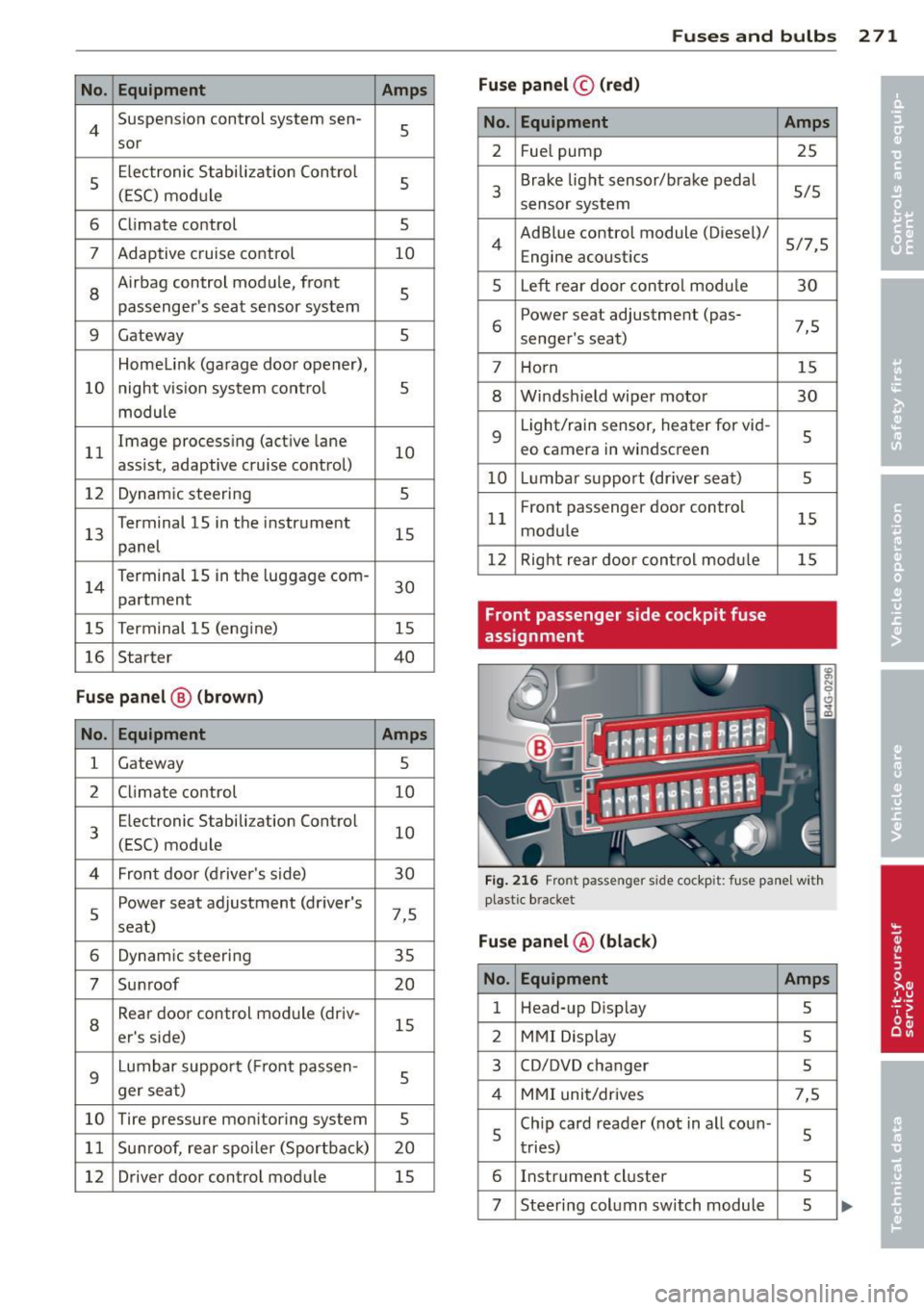
No. Equ ipment Amps
4 Suspension control system sen-s sor
s
E
lectronic Stabilization Cont rol
s (ESC) module
6 Climate control
5
7 Adaptive cruise control 10
8
Airbag control module, front
5
passenger 's seat sensor system
9 Gateway 5
Homelink (garage doo r opener),
10 night vis ion system cont ro l 5
module
11 Image
process ing (act ive lane
10
ass ist, adaptive cruise control)
12 Dynamic steering 5
13 Terminal 15 in
the instrument
15
panel
14 Terminal 15 in
the luggage com-
partment 30
15 Terminal 15 (eng
ine)
15
16 Starter 40
Fuse p anel ® (brown )
No . Equipment Amps
1 Gateway
5
2 C limate control 10
3 E
lectronic Stabili zation Contro l
10
(ESC) module
4 Fron
t door (driver 's side)
30
s
Power seat adjustment (driver's
7,5
seat)
6 Dynam
ic steering
35
7 Su nroof 20
8
Rear door control module (driv-
15
er 's side)
9 Lumbar support (
Front passen-
s ger seat)
10 Tire
pressure monitoring system
5
11 Su
nroof, rear spoi ler (Sport ba ck )
20
12 Driver door
control module
15
Fuse s and bulb s 2 71
Fuse panel © (red )
No . Equipment
2 Fuel pump
3 Brake lig
ht sensor/brake pedal
sensor system
AdBlue control module (Diesel)/
4 Engine acoustics
5 Left rear door cont rol modu le
6 Power seat adjustment
(pas-
senge r's seat)
7 Horn
8 Windshield wiper motor
9 Light/rain sensor, heater
for vid-
eo camera in windscreen
10 L umba r suppo rt (dr iver seat)
1 1 Front
passenger door control
modu le
1 2 Right rea r door cont rol mod ule
Front passenger side cockpit fuse
assignment Amp
s
25
5/5
5/7,S 30
7,5 15
30
s
5
15
15
F ig . 216 Front passenger side cockpit: f use panel w it h
plast ic brac ket
Fuse panel @ (blac k)
No . Equipment Amps
1 Head-up D
isplay
5
2 MMI Display 5
3 CO/DVD changer
5
4 MMI uni t/drives 7,5
5 Chip
card reader ( not in a ll coun -
5
tries)
6 Instrument
cluster
5
7 Steering col umn switch module 5 ...
Page 299 of 304
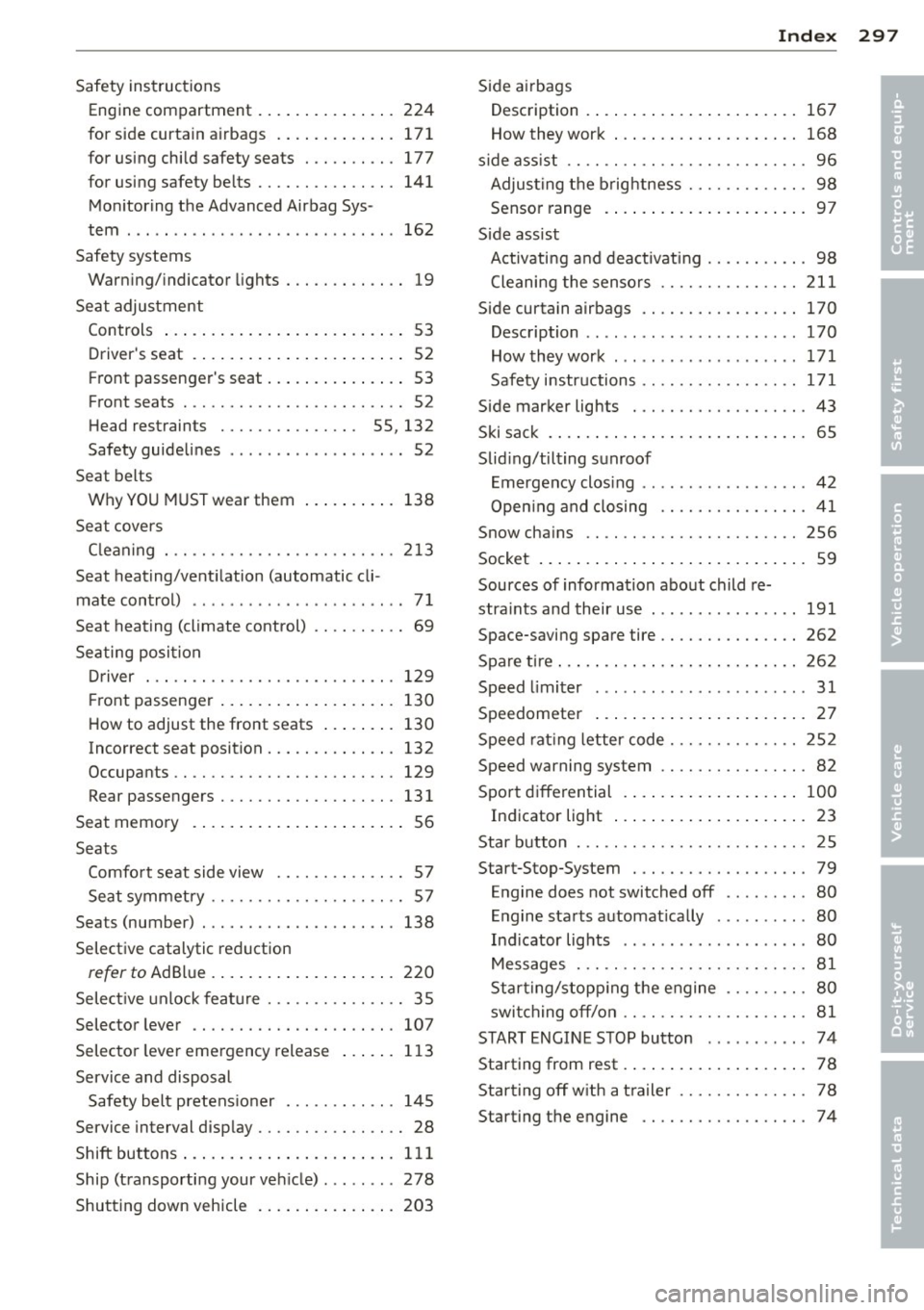
Safety instructions Engin e compartment ... ... .. .. .. .. . 224
for side curtain a irbags . ... .. .. .. .. . 171
for using chi ld safety seats . .. .. .. .. . 177
for using safety be lts ...... .. .. .. .. . 141
Mo nitor ing the Advanced Airbag Sys-
tem . .. .. .. .. ........ ... .. ... ... . 162
Safety systems Warn ing/ indicator lights ... .. .. .. .. .. 19
Sea t adjustment
Controls . . . . . . . . . . . . . . . . . . . . . . . . . . S3
Driver's seat . . . . . . . . . . . . . . . . . . . . . . . 52
Front passenger's seat . . . . . . . . . . . . . . . 53
Front seats . . . . . . . . . . . . . . . . . . . . . . . . 52
H ead restraints . . . . . . . . . . . . . . . 55, 132
Safety guide lines .......... ... ... ... 52
Seat belts Why YOU MUST wear them
138
Seat cove rs
C le a ning . .. ............. .... .. .. . 213
Seat heat ing/vent ilation (automatic cli -
mate con trol) . . . . . . . . . . . . . . . . . . . . . . . 71
Seat heating (climate control) . . . . . . . . . . 69
Seating posi tion
D river ... .. ................. .. ... 129
Fr ont passenge r . . . . . . . . . . . . . . . . . . . 130
H ow to adjust the front seats ... .. ... 130
Incorrect seat position ..... .. .. .. .. . 132
Occupants .. ............. .... .. .. . 129
Rear passengers . . . . . . . . . . . . . . . . . . . 131
Seat memo ry . . . . . . . . . . . . . . . . . . . . . . . S6
Seats Comfo rt seat side view .... .. .. .. .. .. 57
Seat symmet ry ........... .. .. .. .... 57
Seats (number) . .... .... ... .. .. .. .. . 138
Selective catalytic reduction
refer to Ad Bl ue . ... .... ... .. .. .. ... 220
S elect ive un lock fea ture ..... .. .. .. .. .. 35
Selector lever ............. .... .. .. . 107
Selecto r lever emergency release 1 13
Service and disposal Safety belt p retens io ner ... .. .. .. .. . 14 5
Service interval disp lay . . . . . . . . . . . . . . . . 28
Shift but tons . . . . . . . . . . . . . . . . . . . . . . . 111
Ship (transporti ng your ve hicle) . .. ... .. 278
Shutting down veh icle ... ... .. .. .. .. . 203
Inde x 297
Side a irbags
Description . ... .... . ... ...... ... .. 167
How they wor k ... .. . .. ... .... ... .. 168
s ide ass is t . . . . . . . . . . . . . . . . . . . . . . . . . . 96
Adjus ting the brightness ........ .... . 98
Senso r range .. .... . ... ...... ... .. . 97
Side assist Activati ng a nd dea ct ivat ing ...... .. .. . 98
Cleaning the senso rs . . . . . . . . . . . . . . . 211
Side curtain a irbags ............. .. .. 170
Desc ription . . . . . . . . . . . . . . . . . . . . . . . 170
How they work . .. .. ..... .......... 171
Safety instr uctions ............. .. .. 171
Side marker lights .................. . 43
Ski sac k .. .. .. .. .. .. .. ... ..... ... .. . 65
Slid ing/tilt ing s unroof
E mergency clos ing ................ .. 42
Open ing and closing ............... . 41
Snow cha ins .. .. .. ................. 256
Socket ... .. .. .. .... . ... ...... ... .. . 59
Sources of information abo ut child re-
stra ints and their use . .... .... ... .. .. 191
Space-saving spare tire ............... 262
Spare t ire ... .. .. .. .. . .. ... .... ... .. 2 62
Speed limi ter . . . . . . . . . . . . . . . . . . . . . . . 31
Speedometer . . . . . . . . . . . . . . . . . . . . . . . 27
Speed ra ti ng le tter code .......... .... 252
Speed warning system ............... . 82
Sport d iffe ren tial .. .. . ... .... ... .. .. 100
Indicator light ..... . .. .. ..... ... .. . 23
Star button . .. .. .. ............... .. . 25
Start-Stop-System . . . . . . . . . . . . . . . . . . . 79
Engine does not switched off ... ... .. . 80
En gine sta rts automat ically ........ .. 80
Ind icator lights .................. .. 80
Messages . .. .. .. .... ........... .. . 81
Star ting/stopp ing t he e ngine .... .. .. . 80
swi tching off/on .. ................. . 81
START ENGI NE S TOP button ........... 74
Starting from rest . . . . . . . . . . . . . . . . . . . . 78
Star ting off w ith a t railer . . . . . . . . . . . . . . 78
Start ing the engine ............. .... . 74
•
•